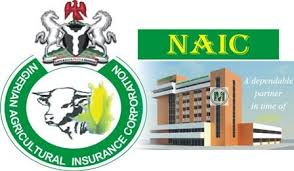Insurance, an effective mechanism of transferring large risks to someone else, has been in use in developed countries for more than one hundred years.
Commercial agricultural finance came into being 26 years ago, an indication that Nigeria is indeed a developing nation even in agricultural production, which has been the main economic backbone of the nation before the discovery of oil in the late 60s.
Evolution of Agricultural Insurance in Nigeria

Agricultural insurance as an alternative for risk management actually started as crop hail insurance in Europe more than 100 years ago, and it spread to the United States at the beginning of the century.
It has since been embraced by many developed and developing countries of the world, including the USA, Canada, Japan, Mexico, Brazil, Bolivia, Costa Rica, Panama, Mauritius, India, Australia, Iran, Sri Lanka, Zambia, the Philippines, Israel, Chile, Jamaica, Egypt, Cyprus, Sweden, Bangladesh, and Venezuela, with varying degrees of success and failure.
In Nigeria, commercial agricultural insurance schemes were pioneered by Niger Insurance in May 1987. National Insurance Corporation of Nigeria (NICON), fully owned by the Federal Government, and the National Cooperative Insurance Society of Nigeria (NCISN) also operated insurance schemes with agricultural implications on a limited commercial scale.
Similarly, some banks, such as the United Bank for Africa (UBA) and Union Bank of Nigeria, which were actively involved in giving credit facilities to the agricultural sector, had to raise the sum assured of life assurance for loan applicants to qualify as suitable collateral for providing loans.
The Agricultural Insurance Scheme (NAIS), which was officially launched on the 15th of December, 1987, was later followed by the incorporation of the Nigeria Agricultural Insurance Company (NAIC) in 1988 to implement the scheme.
Read Also: The Most Lucrative between Production of Fish Fingerlings or Raising them to Table Size
History of Nigerian Agricultural Insurance Corporation (NAIC)

Prior to the establishment of NAIC, Nigerian farmers suffered various losses on their investments and had no means of going back to production. This frustration led many to move into cities in droves in search of easier means of livelihood.
This situation resulted in the depletion of the farming populace, which was a serious threat to food security. The Federal Government became concerned by this trend, leading to the establishment of NAIC to address the needs of farmers.
The need for a specialised Agricultural Insurance Company to provide insurance cover to farmers arose from the Government’s concern over the unwillingness of conventional insurers to accept agricultural risks, which they considered too risky.
This led to the establishment of the Nigerian Agricultural Insurance Scheme on the 15th of November, 1987. Initially, the implementation of the scheme was vested in the Nigerian Agricultural Insurance Company Limited, which was incorporated in June 1988, and later transformed into a Corporation in 1993 by the enabling Act 37 of 1993.
The Nigerian Agricultural Insurance Corporation is, therefore, a wholly owned Federal Government of Nigeria insurance company set up specifically to provide agricultural risk insurance cover to Nigerian farmers.
Vision
To remain the pioneer and leader in the country’s Agro-investment risk management and the preferred choice for general insurance.
Mission
Making investment in agriculture and other sectors of the economy more attractive through efficient risk management that ensures prompt settlement of claims, thereby improving agricultural output and promoting national development.
Agricultural Risks and the Necessity of Insurance
Risks in agricultural undertakings are more widely spread and far-reaching than in most other enterprises. This is because they extend beyond the well-known and researched entrepreneurial hazards and uncertainties of the modern business world. Such hazards include the vagaries of nature, inclement weather conditions, pests, diseases, floods, and fire outbreaks.
These factors can seriously impact the success or failure of any agricultural enterprise. Therefore, any nation with a clear vision to boost its agricultural production, meeting the food needs of its populace and industries, must implement mechanisms that reduce these risks and uncertainties to a bearable minimum.
This underscores the need for an agricultural insurance scheme in Nigeria to keep farmers in business despite these risks.
Read Also: The Ultimate Step-by-Step Guide to Vegetable Gardening
Objectives of Nigerian Agricultural Insurance Corporation

The broad objective of the Nigerian Agricultural Insurance Corporation (NAIC) is to protect the Nigerian farmer from the effects of natural hazards by introducing measures which shall ensure a prompt payment of appropriate indemnity (compensation) sufficient to keep the farmer in business after suffering a loss.
The Scheme is specially designed to:
- Promote agricultural production since it would enhance greater confidence in adopting new and improved farming practices and at the same time bring about greater investments in the agricultural sector of the Nigerian economy, thereby increasing the total agricultural production.
- Provide financial support to farmers in the event of losses arising from natural disasters.
- Increase the flow of agricultural credit from lending institutions to the farmers.
- Minimise or eliminate the need for emergency assistance provided by the government during periods of agricultural disasters.
Problems of Nigeria Agricultural Insurance Scheme
The efficiency of the agricultural insurance scheme in Nigeria has been hampered by the following factors:
1. Inadequate Infrastructure and Support Services: Inadequacy of infrastructural facilities such as good roads and other efficient means of transportation, good communication facilities, and uninterrupted power supply could hamper the successful operation of the scheme. These facilities are needed in order to facilitate prompt and speedy intimation of losses by the farmers for assessment of losses and payment of indemnities.
2. Inadequate Funding: Adequate and timely funding of the scheme will be essential for its success. Agricultural insurance is a very costly venture and as such, arrangement for adequate funding should be made. Delay in approving and releasing funds and especially undue political interference in funding and management of the scheme will affect its success.
3. Lack of Trained Personnel: The scheme requires the availability of personnel trained in agriculture and insurance at the national, state, and local government levels as evaluators, supervisors, loss adjusters, salesmen, and extension staff.
4. Ignorance and Lack of Awareness of the Scheme by Farmers: The ignorance and lack of awareness by the majority of farmers of the need, practice, and values of agricultural insurance constitute a problem for the scheme.
5. Lack of Data: A major problem affecting the scheme is the dearth of data on farm operations, particularly on crop yields and losses arising from natural hazards. These data are necessary for the computation of premiums and indemnities.
6. Perils Covered: The risks covered by NAIC are:
A. In the case of crops, damage or loss caused by:
i. Fire.
ii. Lightning.
iii. Windstorm.
iv. Flood.
v. Drought.
vi. Pests.
vii. Invasion of the farm by wild animals.
B. In the case of livestock, death or injury caused by:
i. Accident
ii. Disease
iii.Fire
iv. Lightning
v. Storm
vi. Flood
7. Conditions for the Insured: A person insured under the Scheme shall satisfy such conditions relating to good husbandry as may be laid down from time to time, by the Corporation.
i. The rate of insurance premium payable under the Scheme by farmers shall be such a percentage of the sum assured as the Corporation may, from time to time, determine, having regard to the pure risk premium, reserve premium, and administrative loading.
ii. The Corporation shall subsidise the premium payable at such a rate not exceeding 50 percent as it may, from time to time, determine. Subsidy on premium shall:
iii. Be paid to the Corporation by the Federal Government and the respective State Governments in the proportion of 37.5 percent and 12.5 percent, respectively; and
iv. For a particular year, be paid within the first quarter of the following year.
Where a State Government defaults in its payment to the Corporation, the Federal Government shall cause the amount to be deducted from funds due to the defaulting State and remitted directly to the Corporation.
8. Indemnity:Indemnity shall be based:
i. In the case of crops, on approved input cost up to the time the loss occurred, but if some crops were salvaged, then less the value of the crops actually harvested;
ii. In the case of livestock, on a valuation table to be prepared by the Corporation for each class of stock; and
iii. In the case of crops, livestock, and other agricultural items specified, from time to time, by the Corporation, on the agreed value of the crops, livestock, or items.
A farmer shall not qualify for indemnity under this Decree unless:
i. The insurance cover was obtained before the damage or loss occurred;
ii. He has a valid insurance cover at the time of damage or loss;
iii. Followed laid down practices for crop and livestock production;
iv. The cause of damage or loss was one of the risks covered by the insurance policy;
v. The notification of the damage or loss was made within the stipulated time; and
vi. He has satisfied such other conditions as the Corporation may, from time to time, specify.
Do you have any questions, suggestions, or contributions? If so, please feel free to use the comment box below to share your thoughts. We also encourage you to kindly share this information with others who might benefit from it. Since we can’t reach everyone at once, we truly appreciate your help in spreading the word. Thank you so much for your support and for sharing!
Read Also: What You Need to Know About Osteospermum

